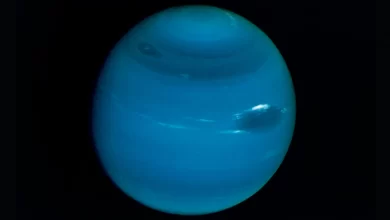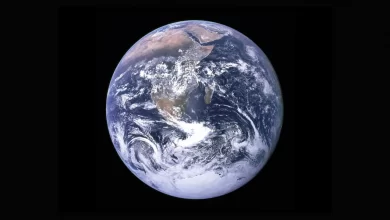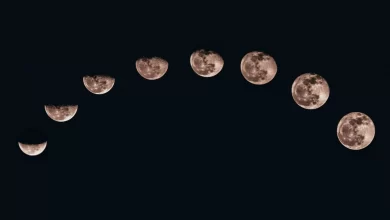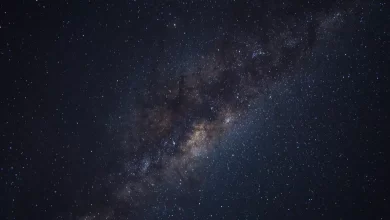After the moon and Venus, Jupiter is the third brightest object in the sky. It is more massive than all of the other planets combined. Jupiter’s shape has been altered as a result of its rapid rotation. Jupiter’s shape has led astronomers to believe that it has a dense, compact core that is ten times the mass of earth. Jupiter’s atmosphere is made up of a series of constantly changing atmospheric bands and the Great Red Spot. It is primarily composed of molecular hydrogen and helium. There are also trace amounts of methane, ammonia, and water vapor in the atmosphere. The abundance of hydrogen and helium on Jupiter is due to its strong gravity. Jupiter has a variety of weather patterns.
- With a radius of 69,911 kilometers43 (440.7 miles), Jupiter is 11 times wider than earth. If earth were the size of a coin, Jupiter would be about as big as a basketball.
- The distance from the earth to Jupiter is 484 million miles (778 million kilometers) on average. Whereas distance between the sun and Jupiter is about 5.2 astronomical units (1Au= distance between the earth and the sun, i.e., 149,597,870.7 km (92,955,807.3 miles) away from the sun.
- The gravity on Jupiter is 2.6 times stronger than that of the earth.
- Jupiter completes one orbit of the sun for every 11.86 orbits by the earth.
- Jupiter spins 28 times faster than earth. A day is just under 10 (Earth hours) long on Jupiter.
- Jupiter is 2.5 times the size of all the other planets in the Solar System combined.
- As Jupiter orbit’s the sun, it leaves a huge trail of gases. Just like the tail of a comet, Jupiter streams out 650 million kilometers (400 million miles) behind the planet.
- On Jupiter, there are no seasons. This due to the fact that the planet does not tilt enough on its axis so that it could produce temperature differences during the year.
- From the time we humans invented the telescope (around 300 years back), we are seeing a huge hurricane on this gigantic planet. The hurricane could be much older than 300 years and is equal to twice the size of the earth.
- On NASA’s website, you can listen to radio broadcasts from Jupiter. There’s no music – just the sound of the planet’s weather!
- Jupiter is made up of just gas with no solid surface to land on. The other planets in our solar system that don’t have a solid surface and are entirely made up of gas are Saturn, Uranus, and Neptune.
- The heat inside the volcano vents on Jupiter’s moon Io can be 1/3rd the temperature of the surface of the sun.
- The Jupiter moon Io has over 400 active volcanoes; it is the most geographically active object in our entire Solar system.
- If the planet Jupiter had been 80 times more massive, it would have formed into a star.
- The brightest stars in the night sky are not actually the stars, but the planets Jupiter, Venus, Mars, and Mercury.
- Jupiter is the fastest rotating planet in the milky way and is over 11 times wider than our blue planet earth.
- When Jupiter was formed, it was much hotter and twice the size it is now; it continues to shrink at a rate of 2 centimeters per year due to heat radiation.
- Jupiter’s magnetosphere is the largest and most powerful of any planetary magnetosphere in the Solar System and, by volume, the largest known continuous structure in the Solar System after the heliosphere. It stretches from Jupiter’s poles to Saturn.
- The gigantic planet Jupiter is heavier than all the other planets put together.
- About 1000 Earths would fit inside Jupiter – and the sun could hold about 1000 Jupiters.
- One of Jupiter’s moons is believed to grow and shrink because of the water beneath its frozen surface.
- The magnetic field of Jupiter is 14 times stronger than that of earth and has 20,000 times more energy.
- Jupiter’s center is a place of extremely high pressure, so high that the core of the planet is thought to be liquid metal, caused by the gases hydrogen and helium changing their form under pressures of 70 million Earth atmospheres.
- Jupiter’s moon Io has land tides from the gas giant’s gravitational pull. The land of Io actually rises and falls by as much as 100 meters, as well as cracking and splitting apart as Jupiter pulls on it.
- Europa, Jupiter’s moon, is completely covered in ice.
- The mass of the asteroid belt that lies between Mars and Jupiter amounts to just 4% of the Earth’s Moon.
- Jupiter’s core is non-metal, but due to the immense pressure inside Jupiter, the core has become a metal. This metal is liquid metallic hydrogen.
- Some of the moons of Jupiter and Saturn appear to exhibit tectonic features. In fact, the Galileo satellite in 1996 photographed a volcano in the act of erupting on Io, a moon of Jupiter. But these volcanoes reflect some other type of melting process, not plate tectonics.
- Jupiter spins right round in less than 10 hours which means that the planet’s surface is moving at nearly 50,000 km/hr.
- Neptune’s moon Triton is the only large moon to orbit backward (retrograde). The only other moons with retrograde motion are Jupiter’s moons Ananke, Sinope, Pasiphae, Carme, and Saturn’s moon Pheobe.
- Jupiter is larger than 1,000 Earths.
- The existence of Jupiter’s magnetic field was first inferred from observations of radio emissions at the end of the 1950s and was directly observed by the Pioneer 10 spacecraft in 1973.
- The Shoemaker-Levy 9 comet smashed into Jupiter in July 1994, with the biggest crash ever witnessed.
- The earth has four major jet streams, Jupiter and Saturn have about 20 jet streams each, and Uranus and Neptune have just three jet streams. The jet stream on the equator flows east on Jupiter and Saturn but west on Uranus and Neptune. Neptune’s jet streams are ten times more powerful than earth’s.
- The largest moon in the Solar System is Jupiter’s moon Ganymede.
- Jupiter has 67 named moons and has more than 100 moons; the vast majority of them are less than 10 kilometers across and were only discovered after 1975.
- Jupiter’s moon Ananke, Sinope, Pasiphae, and carme orbits the planet backward (retrograde).
- A new and tiny moon of Jupiter revolves around the planet in just over 7 hours – making it the fastest moon in the solar system.
- Scientists think Jupiter’s moon, Europa, which is slightly smaller than earth’s moon, contains even more liquid water than all the earth’s oceans put together.
- Jupiter has 2.5 times the mass of all the other planets in the solar system combined and would take more than 11 Earths side by side to cross its diameter.
- Jupiter is so massive that it also controls its own mini solar system. It holds twenty-eight moons in its gravitational thrall – four of which are a match for the planet Mercury.
- Jupiter’s moon Europa may have oceans of water beneath its dry surface, and it is a major target in the search for life in the Solar System.
- Jupiter has no surface for a spacecraft to land on because it is made mostly from helium gas and hydrogen. The massive pull of Jupiter’s gravity squeezes the hydrogen so hard that it is liquid.
- The clouds on Jupiter are 50km(30 miles) thick. Below this, there is a 21,000 km (13,000 miles) thick layer of helium and hydrogens which changes from gas to liquid as the depth and pressure increase.





